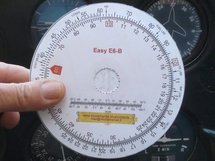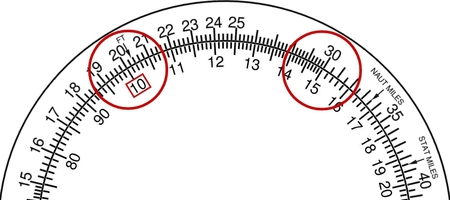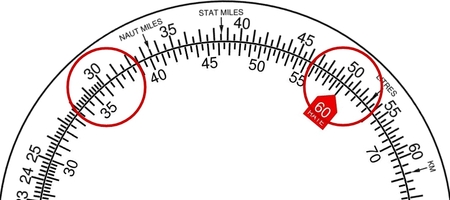The paper E6B template Practice with the virtual E6B
The E6B flight computer
The E6B Fkighr Computer slide rule was the only calculator onboard the airplanes until the mid-1970s.
Conceived in 1600 for maritime navigation, it came to trace the routes of the Jumbo Jet.
Let's see the E6B instructions for multiplication, division and all necessary conversions for the pilots and let's build a paper one with a simple template.
The E6B slide rule were the only calculators available before the electronic age: essentials on board aircraft for reckoning, are still needed as emergency instrument.

1937: the first aeronautical E6B slide rule
The pilots have to find their location and perform various conversions of measures with great rapidity: in this task the slide rule are unbeatable. Mr. Spock used the E6-B on board Star Trek Enterprise: was considered an irreplaceable instrument even in a technological future. The interface of the the E6B slide rule has no equal for dead reckoning and its graphic is used in several navigation software.

2266: the E6B with Mr. Spock onboard Enterprise

The classic E6-B slide rule, one of the most widely used in aviation

The classic interface of an E6B navigation software
The aircraft slide rule, knows as E6-B flight computer, was invented in the '30s and its use is so instinctive that is often preferred to electronic calculators: solves all the problems of flight, finds the angle of drift caused by the wind and it is essential to convert the jungle of measures in which the pilots must unravel. In fact they use indifferently meters, feet, nautical miles, statute miles, kilometers, liters, gallons, etc.

The presentation of the E6B in the 30s
The paper Easy E6B
The Easy E-6B is the reduced version of the slide rule designed in the 30s and still supplied to aircraft. Although it lacks of the graphic for the correction of the routes and of some specialized functions, such as determining the Mach number, is useful in solving problems of travel time, speed, fuel consumption and for make conversions between different units of measure or currency. Easy to build one: download and print the E6B template and it will be ready in 5 minutes.


On the left a real areonautical slide rule, on the right our E6B
It has one mobile outer scale and a fixed inner one with the number 60 (Speed index) marked with an arrow. Remember that, as in the standard slide rule, only the numbers are given: "0.9", "9", "90", "900", "9,000" are always read as "9" and how to locate the dot or how to add tenths or hundreds we must find by ourselves. It is always instinctive to know if we are dealing with tens, hundreds or thousands. Here are some examples, useful in daily life. The complete instructions, with all the aeronautical functions, are included with the template.
1) Multiplication
Example: 12 x 15.
Align 12 on the outer scale with 10 on the inner scale. Then 15 on the inner scale corresponds to 18 on the outer scale. Take into account the position of the decimal point and add one zero to obtain 180.

2) Division
Example: 300/15.
Align 30 on the outer scale with 15 on the inner scale. Then 10 on the inner scale corresponds to 20 on the outer scale. Take into account the position of the decimal point to obtain 20.

3) Time required
Example: Obtain the time required for travel 330 kilometers driving at 55 km/h.
Align 55 on the outer scale with the Speed index (MPH). Then 33 on the outer scale corresponds to 36 on the inner scale. Thus the time required is 360 minutes (6 hours). Can also be calculated in miles instead of kilometers.

4) Average speed
Example: obtain the average speed (km/h) needed to travel 120 kilometers in an hour and 30 minutes.
Align 12 on the outer scale with 90 (minutes) on the inner scale. Then the Speed index (MPH) corresponds to 80. Thus the average speed is 80 kilometers per hour.

5) Rate of fuel consumption
Example: obtain the hourly rate of fuel consumption for 5 h running time and a total consumption of 35 liters.
Align 35 on the outer scale with 30 on the inner scale (300 minutes = 5 hours). Then the Speed Index (MPH) corresponds to 70. Thus the fuel consumption rate is 7 liters per hour.

6) Fuel required
Example: obtain the fuel required for a trip with 6 l/h of consumption and a running time of 5 h. Align 60 on the outer scale with the Speed Index (MPH). Then 30 on the inner scale (300 minutes = 5 hours) corresponds to 30 on the outer scale. Thus the fuel required is 30 liters.

7) Estimated running time
Example: obtain the estimated running time with 5 l/h of fuel consumption and a tank of 30 liters.
Align 50 on the outer scale with the Speed Index (MPH). Then 30 on the outer scale corresponds to 360 on the inner scale. 360 minutes = 6 hours thus the estimated running time is 6 hours.

8) Distance
Example: convert 45 miles into nautical miles and kilometers.
Align 45 on the outer scale with STAT on the inner scale. Then NAUT corresponds to about 39 and KM to about 72 km.


The paper E6B is useful also on helicopters

The E6B has been included in the watches dedicated to pilots
The backside side of the E6B
We have seen how the front of the The E6B slide rule serves to calculate distances and make conversions, timing or power consumption. The back, inspired by the graphic Raxon de Martelojo, invented in 1400 for maritime navigation, is used to solve the problems of reckoning.


Raxon de Martelojo navigation computer, 1430, and modern E6B
We see how determine the changes of direction and speed needed to compensate the wind. Our paper model does not have these features.
Example: You have laid out a course on a chart and measured it to be 090° true. The winds aloft forecast calls for the wind at your chosen altitude to be 230° at 18 knots, and the performance data for the airplane says that you can expect a true airspeed of 125 knots at that altitude.
- Set 230° at the TRUE INDEX.
- Using any convenient starting point, measure 18 units up from the grommet toward the True Index and make a dot at 18 units (Fig. 1).
- Rotate the transparent disk to bring 090° to the TRUE INDEX.
- Move the slide until the wind dot falls on the arc for 125 knots (Fig. 2).
- Read the ground speed of 138 knots under the grommet; the fact that the wind dot is below the grommet indicates a tailwind.
- The wind dot is 5° to the right, indicating that the true heading should be 095°. Now all you have to do is apply local magnetic variation to correct the compass.
- We are a bit faster and we can slow down of 13 Knots to respect the time of the flight plan.


Fig. 1 Fig.2

Until the '70 on board the aircraft was only used the E6B
and today is still required: always work in any situation!
E6B Links:
The E6B on Wikipedia
Mastering the E6B
© 2004 - 2025 Nicola Marras Manfredi
